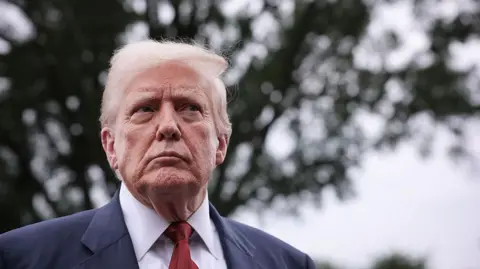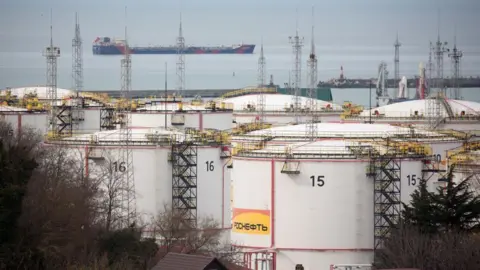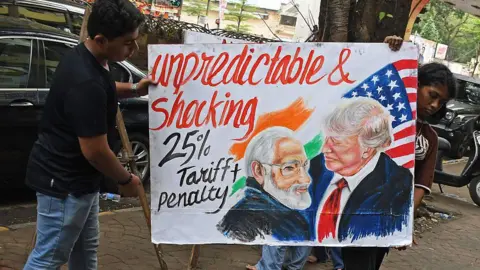 Getty Images
Getty ImagesDespite being the world’s most sanctioned country, Russia has continued to use its vast energy wealth to bankroll its war in Ukraine.
US President Donald Trump is hoping to change that. He has announced that sweeping new secondary tariffs will impact any country still trading with Russia if a ceasefire with Ukraine is not agreed by Friday 8 August.
Secondary tariffs would see goods from any country that trades with Russia face a 100% tax when they are imported into the US.
Oil and gas are Russia’s biggest exports, and Moscow’s biggest customers include China, India and Turkey.
“I used trade for a lot of things, but it’s great for settling wars”, said Trump last month.
This would not be the first time the Trump administration has imposed secondary tariffs, which are also in place to punish buyers of Venezuelan oil.
However, using them against Russia would have far bigger implications for the global economy.
Russia remains the world’s third biggest oil producer, behind only Saudi Arabia and the US itself. But its shipments have been falling this year, according to a Bloomberg analysis of ship-tracking data.
 Bloomberg
BloombergIncreased energy prices
“The key channel by which secondary tariffs on buyers of Russian energy could impact the global economy would be through the level of energy prices,” says Kieran Tompkins from the consultancy Capital Economics.
If the tariffs work, they will cut the flow of Russian oil and gas to global markets.
And with less supply, prices could go up, just as they did when Russia launched its full-scale invasion of Ukraine in 2022. That led to a spike in inflation around the world. President Trump says he isn’t worried because of record US oil production.
Mr Tompkins points out that, this time, there are also other reasons to suggest the impact on prices would not be as marked.
He explains that “the current backdrop is one where OPEC+ [the group of major oil producing countries and its allies] have significant spare capacity to draw upon.”
Russia has devised a whole system for avoiding existing sanctions, which could be useful for helping its trading partners avoid the secondary tariffs threatened by Trump.
For example, its so-called “shadow fleet” – consisting of hundreds of tankers with obscure ownership – could be used to conceal the origin of exported Russian oil and gas.
“Sanctions maintenance is as big a task as the imposition of sanctions in the first place,” US sanctions expert Richard Nephew of Columbia University says.
“That’s because the party that is being sanctioned takes steps to evade them.”
 Ashish Vaishnav/SOPA Images/LightRocket via Getty Images
Ashish Vaishnav/SOPA Images/LightRocket via Getty ImagesPricier iPhones from India
Since the full-scale invasion of Ukraine in 2022 India has been the second biggest buyer of Russian oil, according to the Centre for Research on Energy and Clean Air.
“They’re fuelling the war machine. And if they’re going to do that, then I’m not going to be happy,” President Trump told US outlet CNBC on Tuesday.
If secondary sanctions take effect, US companies buying goods from India will have to pay a 100% import tax – or tariff – when those products reach US shores.
The idea is that it makes these goods so expensive that US businesses will choose to buy them cheaper from elsewhere, resulting in lost revenue for India.
That, in turn, is supposed to deter India from buying Russian oil. And if Russia is left unable to sell its oil elsewhere because other countries face the same predicament, it will have less cash to finance the war in Ukraine.
One way in which Americans could experience higher prices as a result of new secondary tariffs is in their purchase of mobile phones from India.
US firm Apple is moving much of its iPhone production to India – in particular the manufacturing of handsets that it wants to sell in the US.
If these products are subject to the new tariffs, prices could double for US consumers. That is because tariffs are paid by the companies that import goods – and those companies tend to pass most, if not all, of their cost increases on to their customers.
Imports to the US from India are already facing a 25% tariff as part of President Trump’s broader trade shake-up, and he told CNBC that number could be raised “very substantially”.
India’s government has accused the US of double standards, pointing to Washington’s own continued trade with Russia.
The vast majority of that trade is made up of US imports from India which amounted to just over $3bn (£2.2bn) last year – although that’s just 10% of 2021 levels.
That trade is dominated by US purchases of raw materials for nuclear energy and fertilizers. Russia is a major global supplier of both.
Derailing trade talks with China
China is buying the most Russian oil, and a decision by President Trump to impose secondary tariffs on Chinese goods would be much more challenging to fulfil.
That’s because US imports from China are worth five times as much as those from India, and a lot more of those imports are consumer goods such as toys, clothes and electronics.
Secondary tariffs aimed at Beijing would also risk upsetting a much broader renegotiation of trade between the world’s two biggest economies that Trump has been pursuing since his first term in office.
“This type of over-escalation is unlikely to impress the Chinese,” says trade expert Professor Simon Evenett of IMD Business School.
He explains that it would be “very difficult” to peel the Chinese away from the Russians without a good reason, given how closely Presidents Xi and Putin have worked together in recent years.
On top of that, the last time Trump tried using triple-figure tariffs against China, he found it did not work – as it almost cut off all trade between the two countries.
Another move like that could add to inflationary pressures in the US, which Trump has long pledged to tackle.
It could also cost huge amounts of manufacturing jobs in China, at a time when its economy is already struggling on several fronts.
Further harm to US-EU commerce
Analysis by the Finland-based Centre for Research and Clean Air shows that the EU and Turkey are also still amongst the biggest buyers of Russian energy.
Before 2022, the EU was the number-one export destination for Russia, although that has been vastly reduced since the full-scale invasion of Ukraine. Brussels recently agreed to buy a lot more energy from the US, but some imports from Russia remain.
In June, the president of the European Commission, Ursula von der Leyen, acknowledged the problem, saying “Russia has repeatedly attempted to blackmail us by weaponizing its energy supplies” as she laid out plans to end imports by the end of 2027.
The US-EU trade relationship is the biggest in the world, and the pair have just negotiated new trade terms which will see a 15% tariff be applied on most EU exports to the US.
Many in the EU criticised that deal, saying the tariffs would harm European exporters.
Now they also fear that secondary sanctions on the EU could do even more harm. Adding 100% tariffs for buying Russian energy could significantly reduce the amount of goods sold by the EU to the US.
However the biggest sellers include pharmaceuticals and machinery, which may be hard to source from elsewhere – meaning Americans have little choice but to pay more.
Potential Russian recession
Russia’s own economy has so far proven remarkably resilient since the full-scale invasion of Ukraine began, growing 4.3% last year.
However, Economy Minister Maxim Reshetnikov recently warned that the country was “on the verge” of recession after a period of “overheating”. The International Monetary Fund (IMF) is forecasting growth of just 0.9% this year.
If the secondary sanctions are successful in reducing demand for exports, they will push Russia closer to recession.
The exact impact of the war on Russia’s economy is hard to know, because Moscow has prevented a large amount of economic data from being published since the full-scale invasion – including on oil and gas production.
About a third of Russian government spending is funded by oil and gas money, but exports have been falling.
Meanwhile, Putin is directing a bigger share of spending towards defence than at any time since the Cold War. Defence spending is believed to have reached 6.3% of GDP.
By contrast, Ukraine has been spending a huge 26% of the value of its far-smaller economy on the war. The difference explains why its president, Volodymyr Zelensky, has repeatedly asked for external help from his allies.
Trump’s tariffs are intended to help Zelensky by cutting the amount of money flowing into Russia, and he hopes bring an end to the death, suffering and destruction in Ukraine.
Source link
[ad_3]
[ad_4]


